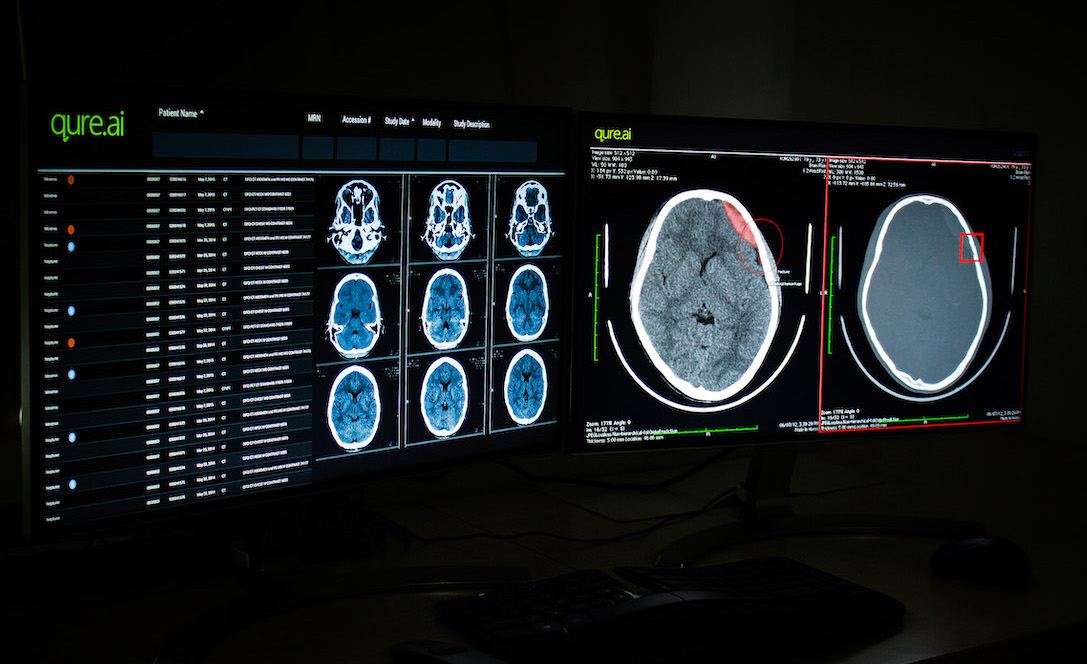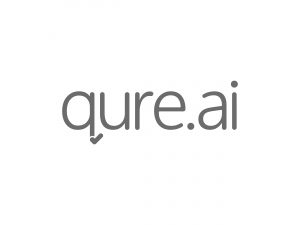Qure.ai’s team of experts work to define clinically relevant problems and design real-world solutions that are deployed in 20 countries around the globe. The company seeks to improve diagnostic efficiency and accuracy in radiology, with an initial focus on chest X-rays and head CTs. Once FDA-cleared, Qure.ai solutions will be integrated with Nuance’s next-generation reporting platform, PowerScribe One.
Access to accurate and early diagnosis has become key to delivering quality healthcare around the globe. In many locales, the doctor-patient ratio is low, and even more so in the case of specialized practitioners such as radiologists. In underserved and remote regions, radiologist expertise is scarce, costly, and unequally distributed. Even in developed parts of the world, workloads are creating burnout issues and higher error rates for radiologists. This means that not all patients receive the most accurate, timely diagnosis. AI-driven radiology solutions can automate a lot of the routine work, saving precious time for radiologists and help mitigate clinician burnout.
Chiranjiv Singh, Chief Commercial Officer of Qure.ai, shares his insights about how Qure.ai’s solutions aim to make radiologic diagnoses more accurate and efficient, delivering AI capabilities within radiologists’ everyday workflows to optimize results and deliver better patient care.
Qure.ai’s product philosophy is to solve clinical and workflow needs of customers and to go deep into certain areas rather than spreading across a spectrum of clinical areas. Qure.ai has trained its AI models on more than 7 million exams sourced globally and prides itself on having been validated by multiple papers in peer-reviewed research. In line with this philosophy, Qure.ai has commercially released two AI models to date, one focusing on detecting abnormalities in chest X-rays and the other for triage and diagnostic support of head CT scans. As of writing, the CT algorithm is 510(k) Pending with the US FDA.
Q&A
Jonathon Dreyer: Tell us about your business – when and how you started and your development journey.
CS: Qure.ai is a healthcare AI startup that applies artificial intelligence and deep learning technology to radiology imaging for quick and accurate diagnosis of diseases. Our AI models can automatically detect clinical findings and highlight the relevant areas from X-rays, CT scans, and MRIs in a few seconds. This allows physicians to spend more quality time with patients to better understand their specific case/symptoms, communicate the diagnosis, and determine and discuss customized treatment plans – leading to better patient care.
Qure.ai was founded in 2016 by Prashant Warier and Dr. Pooja Rao. Prashant is a career data scientist and entrepreneur, and Pooja is a trained clinician. Together they bring complementary skills of engineering and medicine critical to product development. From humble beginnings in India 3 years ago, Qure.ai is now present across 20 countries through 80+ deployments and has processed more than 600,000 scans.
Our solutions have been validated and reviewed by clinicians at leading healthcare institutions such as the Massachusetts General Hospital and the Mayo Clinic, among others. The Lancet published validation of our technology, making it the first radiology AI article released by the journal. Qure.ai’s software is vendor-neutral and is deployed online with cloud-based processing capabilities integrated with the radiologists’ current reporting workflow.
JD: What AI models do you have and what do they do?
CS: We have two commercially released algorithms so far and are working to get them regulatory cleared for clinical use in the US market.
- qXR scans abnormal chest X-rays to identify and localize 18 clinically relevant findings with an accuracy of over 95%. We have deployed this in various use cases, from screening to radiology assistance, to even post-read quality control. For example, qXR can screen for tuberculosis and is used in public health screening programs globally. When used as a point-of-care screening tool for TB, followed by immediate bacteriological/NAAT confirmation, qXR significantly reduces time to diagnosis.
- qER is the only AI model in the market that can detect all possible critical findings from a non-contrast head CT scan. qER is designed to triage critical cases and provide diagnostic assistance in head CT scans – a first-line diagnostic modality for patients with head injury or stroke. qER automatically detects intracranial hemorrhages (ICH) and its subtypes (intraparenchymal (IPH), intraventricular (IVH), subdural (SDH), extradural (EDH) and subarachnoid (SAH)), cranial fractures, midline shift and mass effect from non-contrast head CT scans.
JD: What’s the big “Aha” moment when you first show users what your AI model(s) can do for them?
CS: The first Aha moment we get from customers is the depth of our capability. Unlike other AI models in the market that may detect only a few findings on x-ray, we are able to detect and show accuracy numbers on 18 clinical findings from qXR. Similarly, for qER, we detect multiple sub-types of ICH along with cranial fractures, midline shift and mass effect – a larger triage capability than what most customers have seen so far from other AI vendors.
The next big Aha is when customers see our richness of peer-reviewed publications. Every AI company wants to claim high accuracy numbers, and yet there is a lack of trust among clinicians. We take this job of building trust as core to our company and therefore have invested resources to expose our algorithms to multiple independent reviews and peer-reviewed publications that help us reduce that trust deficit. The fact that our algorithms can identify and label the exact abnormalities, as well as their locations within the scans in a matter of minutes, with near-radiologist accuracy in a clinical setting, has been our biggest highlight.
Lastly, our integration within radiology workflow is the final wow! For example, we are working with Nuance to integrate our AI model outputs in PowerScribe One to allow radiologists to consume these outputs according to their preferred workflow. We are also integrating our outputs to help to prioritize radiologist worklists using PowerScribe Workflow Orchestration.
JD: What challenges or needs did you see that drove you to focus on this?
CS: Access to accurate and early diagnosis is crucial to delivering quality healthcare. In many places around the world, the availability of specialized radiology resources is limited. And even in more developed countries, the volume is increasing exponentially, putting limits on the ability of radiologists to deliver timely, accurate diagnoses. Burnout is increasing as well as the potential for errors. Our solutions can help automate a lot of the routine work, saving precious time for radiologists and thereby preventing clinician burnout.
We saw this as a need and simultaneously an opportunity to leverage the power of deep learning to develop solutions dedicated to this market. Our mission is to use artificial intelligence to make healthcare more accessible and affordable.
JD: What’s the number one benefit you offer?
CS: The number one benefit we offer our users is “trust and peace of mind.” This is possible only when a product is reliable and also invisible. We want our users – be it radiologists or public health experts – to focus on their patients and trust us for the accuracy of our AI models. We also want to embed ourselves into their workflow in a manner that almost becomes invisible to their daily practice. We believe that our AI solutions shall be successful only if we are able to build integrated solutions with companies like Nuance that solve clinically relevant problems.
This is easier said than done. It means working hard to build solutions that are globally trained and validated, built on a large volume and variety of data, and embedded into diverse clinical workflows. It’s the challenge of meeting our customers’ expectations on this benefit that keeps us up at night.
JD: Are there any stories you can share about how your AI model(s) drove measurable patient care outcomes?
CS: One of our customers is the Philippine Business for Social Progress, a local screening agency and the first adopter of artificial intelligence algorithms for tuberculosis detection in the Philippines. Working with their team, we built a custom, end-to-end TB workflow and patient registration software that helps health workers immediately refer potential TB suspects for confirmatory tests. Our solution is deployed in multiple mobile vans that move across different pockets of Manila and have been in use for >6 months. Prior to using qXR, the time to complete a patient diagnosis was >2 weeks. We have reduced that time to <1 day (from screening to x-ray to lab tests). We have identified 25% more TB cases than the original workflow and have screened 30,000+ individuals using our AI solution.
JD: What benefits does Nuance and its AI Marketplace for Diagnostic Imaging bring to your users? What problems does the marketplace and integration into Nuance’s workflow solve?
CS: Nuance and its AI Marketplace brings two key benefits to our users. The first benefit is that it offers a single platform to review, try, and buy AI models. Customers need a trusted partner with vetted solutions that connect trusted AI developers to clinical users. The Nuance AI Marketplace does this for every stakeholder in the user organization – clinicians get access to algorithms they can evaluate for clinical accuracy; IT administrators get easy integration without running multiple deployment projects with independent vendors; purchase/finance teams get streamlined negotiations and reduced time to execute multiple contracts.
The second and equally important benefit is seen once the purchase decision has been made. For our solutions to work and be used, they need to be accessible to the users when they are reviewing images and dictating their reports. We want to embed ourselves into customers’ workflow in a manner that is almost invisible to their daily practice. Nuance offers the right point and platform for this integration into the radiologist workflow for AI solutions like ours, and we are really excited to be part of this platform.
JD: What has your experience been working with the Nuance team?
CS: The experience of working with the Nuance team has been one of dealing with a team that is not only professional but also extremely knowledgeable and proficient in diagnostic imaging and reporting workflows. They understand the use cases of bringing in technologies like AI to meet real needs of their customers. I am looking forward to this partnership as we jointly work with our customers and deliver value to them.
JD: What is your vision for how your solution(s) will evolve over the next 5 years?
CS: In the next five years, I see us offering more comprehensive solutions across various clinical domains, solving customer challenges at various points in the diagnostic journey of patients. We will enhance our capabilities by increasing our clinical coverage beyond chest x-ray and head CT that we offer today. In terms of diagnostics workflows, we see ourselves being able to offer more measurement and diagnostic tools to aid radiologists in their reads and even do tasks like treatment progression monitoring to aid other clinical users. Five years is a very long time in the field of AI, and I am confident that Qure.ai will be a dominant global player and a trusted partner for our customers over that time frame.
JD: In one sentence, tell us what you think the future of medicine will look like?
CS: The future of medicine will be custom designed and served, focusing both on prevention and cure, and most importantly, accessible to all.
Learn more
To learn more about Qure.ai, please visit www.qure.ai
To learn more about Nuance AI Marketplace for Diagnostic Imaging, please visit https://www.nuance.com/healthcare/diagnostics-solutions/ai-marketplace.html








